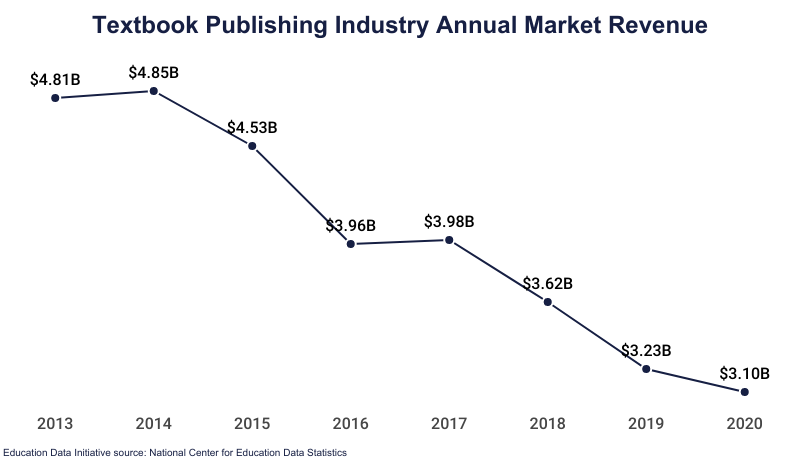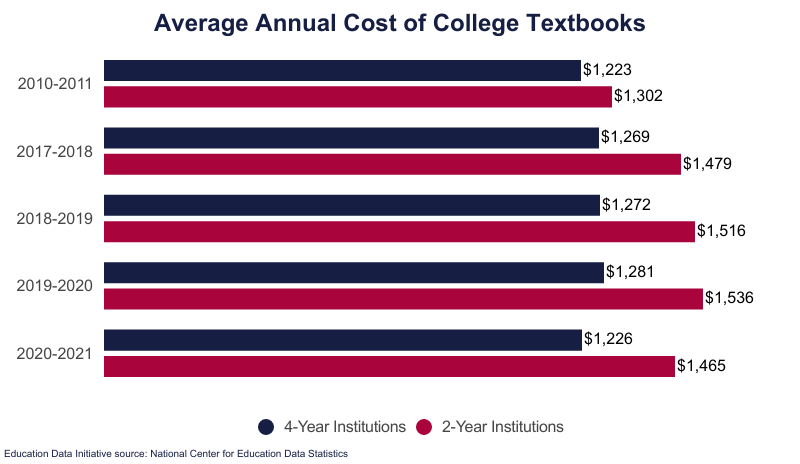Report Highlights. The cost of college textbooks ballooned for years, but increased use of ebooks has reduced the cost to the consumer; an ebook can be 50% less expensive than its hard copy counterpart.
- The average college student spends $174 on new, printed textbooks for the year.
- The textbook publishing industry is valued at $3.18 billion.
- The average college student pays $285 for course materials in one academic year.
- 25% of students reported they worked extra hours to pay for their books and materials; 11% skipped meals in order to afford books and course materials.
- 65% of college students skipped buying textbooks because they were too expensive.

Related reports include: Average Cost of College & Tuition | Cost of a College Class or Credit Hour | How Do People Pay for College? | Average Student Loan Debt
Average College Textbook Costs
The average cost of college books and supplies declined in the 2021-2022 academic year, in part due to an increased rate of textbook rentals and use of digital course materials.
- The average postsecondary student spends between $1,212 annually for books and supplies as of the 2022-2023 academic year.
- Hard copy books can cost as much as $400, with an average price between $100 and $150.
- The price of textbooks increases by an average of 6% each year, doubling every 11 years.
- Textbook prices are rising roughly 3 times the rate of inflation.
- College tuition and fees have risen over 167% in the past 20 years.
- Between 1977 and 2015, the cost of textbooks increased 1,041%.
- Most of the postsecondary faculty do not know the cost of course materials when they select them for their classes.
Average Cost to Students
Most professors believe the cost of course materials is a burden to their students.
- 20% of students who fail college courses are due to the cost of textbooks and class materials.
- 2022 had the lowest reported course material cost over the past 15 years.
- 82% of professors say textbooks and course materials cost their students too much.
- Yet, only 8% of professors have initiated textbook cost-saving programs for students.
- Consumer prices for textbooks has increased up to 7.2% from 2020 to 2023.
Average College eBook Costs
Increased online and distance learning necessitates a wider use of e-texts, which students may purchase for sale, subscription, or rent.
- The cost-per-student of eTextbooks increased by 37% over 12 months.
- 40% of professors support the use of eBooks and online technology for their coursework.
- Since 2009, students and parents can also qualify for a $2,500 textbook and course material tax credit by submitting an IRS Form 8863 with their annual taxes.
Low-Cost & No-Cost College Textbooks
One response to rising prices is the adoption of course materials that are part of a shared resource system. These systems are most beneficial to students and faculty; meanwhile, publishers and institutions miss out on profits.
- 13% of postsecondary institution professors require the use of open education resources (OERs) for students.
- 39% of faculty members are aware of OER licensing.
- 61% of professors say that over 90% of their students have access to all required course materials such as textbooks.
- 16% of faculty have adopted free or open-source textbooks.
- Less than 50% of professors replace textbook material with information they wrote or from other available sources.
- There was a shift in the teaching paradigm that was noted by professors currently preferring online materials vs. hard copy or printed textbooks for teaching.
- 29% of higher educational faculty require an OER in their class, and 50% of faculty rank their course material at an A or B level.
How to Save Money on College Textbooks
About one-in-five students report that the cost of books and materials directly influences their decision on what classes to take, and 63% of students say they’ve skipped buying a textbook altogether.
- Apply for book scholarships. Scholarships cover just about everything else, and there are many out there specifically for course materials.
- Use your tax credit. The American Opportunity and Lifetime Learning Education Credits allow you a $2,500 tax credit for course materials purchased. Fill out and submit an IRS Form 8863 with your annual taxes.
- Check for Open Educational Resources. Also known as OERs, OEMs, or OSMs, these open-source course materials are developed specifically for free use and distribution. A growing number of universities are allowing their faculty to adopt these course materials to help reduce costs for students.
- Look for discounts or access programs. You may find discounted rates for books and subscriptions your school may have negotiated with the publisher.
- Buy prior editions. Many publishers still release new editions of textbooks year after year that change very little from one edition to the next. Your instructor can probably tell you if there are any significant changes to the book from the prior edition.
- Buy used books, rent books, or look locally. See if the book is available at a library. Also be sure to check out local booksellers and book buyers.
- Share books. Share with roommates or classmates who are taking the same classes. See if other students who took the class the prior semester are selling the book you need and cut out the middleman entirely.
- See if your required texts are free online. Some of our favorite resources are:
- Google Scholar searches and links to academic resources. Scholar does not necessarily provide access to the full text for each search result, but it’s a good method for locating titles.
- Internet Archive, home of the Wayback Machine, is a nonprofit that hosts and searches millions of free books, audio, film, and more.
- Project Gutenberg and the Project Gutenberg Literary Archive Foundation has archived over 60,000 books for open access.
- OpenStax from Rice University is a 501(c)(3) nonprofit that is 100% free to users and packed with peer-reviewed resources on every subject.

The College Textbook Industry
Three (3) publishers control over 80% of the U.S. college textbook market: McGraw-Hill, Pearson, and Cengage.
- The textbook publishing industry was valued at $3.18 billion in 2022.
- Pearson had a 14% drop in textbook sales in 2021, while maintaining a 14% increase in online learning and a 41% increase in virtual school enrollment.
- Pearson saw a 32% growth in Q3 of 2020.
- Cengage saw a 40% year-over-year growth in online skills revenue, and its digital sales have now offset the setbacks from declining hard copy book sales.
- 77% of postsecondary faculty report that in meetings with publisher sales representatives, prices of books are rarely volunteered.
- 38% of faculty report they’ve received a direct answer about price information when they asked for it.
- Publishers market “bundles” of books and course materials that cannot be bought separately, yet only 50% of instructors indicated they utilized the extra materials.
- 33% of faculty could not adopt the textbook of their choice without the bundled material or were unaware if it was an option.
Analysis: Why Are College Textbooks So Expensive?
New textbooks are expensive whether they are hard copy or digital. While digital or ebooks offer convenience, many make use of access codes, which ensure every student pays full price. An access code gives a student temporary use of a learning management system (LMS) with the course materials, complete assignments, and access to other critical resources necessary to complete their online class.
Schools with “inclusive access” agreements make these course materials mandatory. In other words, where students could once share textbooks or buy them used, purchasing the new text is now compulsory.
Called a “conspiracy” in a class action antitrust lawsuit filed against major textbook publishers, the inclusive access model builds the cost of online course materials into tuition fees. Because this model guarantees a number of textbooks purchased, the publisher can offer a quantity discount; this deal benefits both the publisher and the academic institutions. Students enrolling in these classes, however, have no way to opt out of paying for the textbook; they also cannot recoup a percentage of the cost of the book by reselling it after they’ve completed the class.[1]
Sources
- Bloomberg Law, Court Dockets: Case 1:20-cv-00102-UNA
- American Enterprise Institute, The New Era of the $400 Textbook
- U.S. Department of Education National Center for Education Statistics, Digest of Education Statistics: Current Tables
- U.S. Public Interest Research Group, Fixing the Broken Textbook Market
- SpringerLink, COVID-19 and Book Publishing: Impacts and Insights for 2021
- The Association of American Publishers (AAP), A Victory for Affordability: Student Spending on Course Materials Declines 22% During the 2021-2022 Academic Year
- AAP, Student Monitor Fall 2020 Preview: Multi-Year Decline in Student Spending on College Course Materials Continues
- Inside Higher Ed, OER Adoptions, Awareness Continue to Grow, But Many Faculty Members Still Hold Out
- Bay View Analytics, Digital Texts in the Time of COVID
- eLiterate, How Much Do College Students Actually Pay for Textbooks?
- NBC News, College Textbook Prices
- U.S. Bureau of Labor Statistics (BLS), College Tuition and Fees
- Florida Virtual Campus, 2016 Student Textbook and Course Materials Survey
- Student Public Interest Research Groups, Exposing the Textbook Industry
- Inside Higher Ed, Professors’ Slow, Steady Acceptance of Online Learning: A Survey
- Hetchinger Report, A textbook delemm: Digital or paper?
- AAP, Student Spending on College Course Materials Continues Multi-Year Decline
- AAP, StatShot Annual Report
- National Academy of College Stores, Student Watch Report: Course Materials Spending Dropped, Increase in Digital Preference
- U.S. News, 15 Ways to Cut Your Textbook Costs